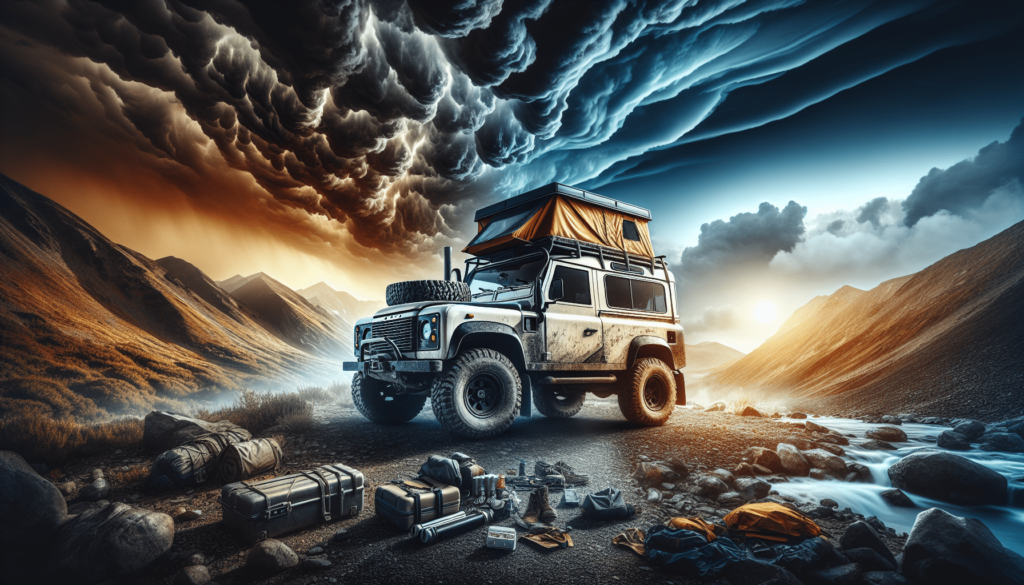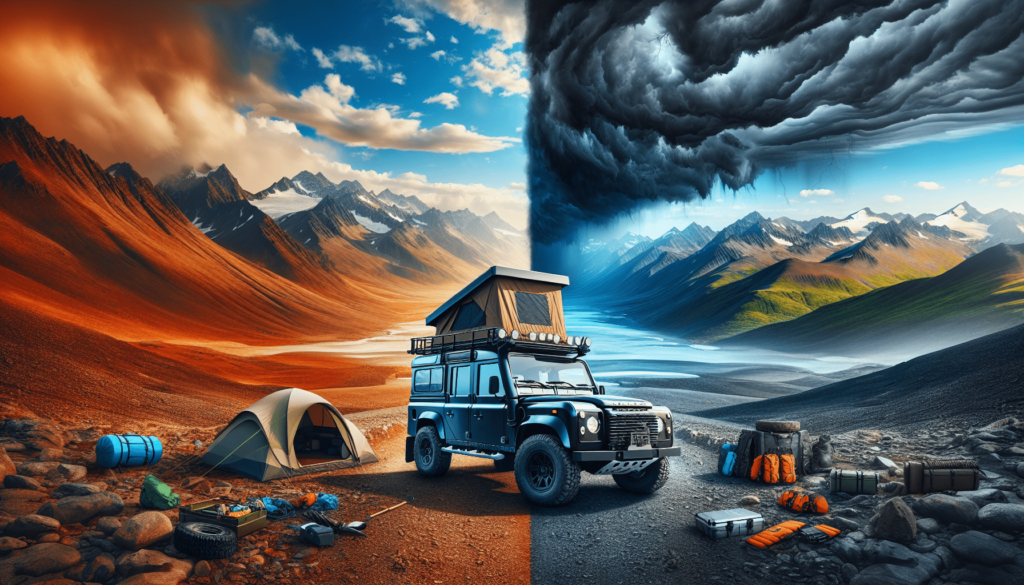Have you ever thought about what it takes to prepare for an overlanding adventure in areas known for their wild, unpredictable weather? Overlanding is an exhilarating experience, but tackling regions with extreme weather patterns can be a daunting task. Here’s how you can gear up to make the most out of your journey.
Understanding Extreme Weather Patterns
Extreme weather patterns can significantly impact your safety and enjoyment during overlanding. Whether you’re facing intense heat, heavy rainfall, or blizzards, understanding these conditions is the first step to preparation.
The Importance of Research
Before you embark on your adventure, take the time to research the specific weather patterns of your destination. Are you heading into a desert region or a mountainous area? Each will present unique challenges. Knowing what kind of weather to expect helps you plan accordingly.
Typical Extreme Weather Conditions
Familiarizing yourself with common extreme weather conditions encountered during overlanding can be beneficial. Some of these include:
| Weather Condition | Description |
|---|---|
| Heat Waves | High temperatures can lead to dehydration and heat exhaustion. Preparing for hydration and cooling is critical. |
| Heavy Rainfall | Sudden downpours can create muddy and dangerous driving conditions. Understanding how to handle these situations is crucial. |
| Snow and Ice | Cold temperatures and icy roads require specific gear and vehicles capable of handling such extremes. |
| High Winds | Strong winds can topple trees and create difficult driving conditions. You need to choose your campsite wisely. |
Understanding these conditions can shape the gear you carry and the routes you take.
Essential Gear for Extreme Weather
Packing is one of the most critical aspects of preparation. The right gear can make or break your overlanding experience in extreme weather.
Clothing for All Conditions
Proper clothing is essential in keeping you comfortable and safe while overlanding. Here’s a breakdown of what to consider:
| Type of Weather | Clothing Suggestions |
|---|---|
| Hot Weather | Light, breathable fabrics (e.g., moisture-wicking shirts, shorts, and hats) |
| Cold Weather | Layered clothing, thermal undergarments, waterproof outer layers |
| Rainy Weather | Waterproof jacket, quick-dry clothing, and sturdy boots |
| Snowy Weather | Insulated jackets, gloves, thermal socks, and waterproof pants |
Remember, layering is key. This approach allows you to adjust your comfort based on changing weather conditions.
Shelter and Sleeping Gear
Your choice of shelter is just as critical. A good tent can shield you from rain and wind, while a quality sleeping bag ensures you stay warm during cold nights. Consider the following:
- Tent: Look for waterproof, breathable materials, and ensure it’s easy to set up.
- Sleeping Bag: Choose one rated for temperatures lower than what you expect to encounter.
- Sleeping Pad: An insulated pad can provide comfort and extra warmth from the ground.
Vehicle Preparation
Your vehicle is your lifeline in overlanding. Preparing it for extreme weather conditions ensures you can navigate challenges confidently.
- Tires: Make sure your tires are up for the terrain and climate. In snowy regions, consider snow tires or chains.
- Fluids: Check the levels of your oil, coolant, and windshield wiper fluid. Cold temperatures can cause fluids to freeze or become less effective.
- Lighting: Ensure that all lights work. Visibility is vital during heavy rain or snow.

Tips for Hydration and Nutrition
Staying hydrated and well-nourished is essential for maintaining your energy and health while overlanding.
Hydration Strategies
Dehydration can sneak up on you, especially in hot conditions. Here are some ways to ensure you stay hydrated:
- Carry Enough Water: A general rule is to have at least one gallon per person per day, but this can vary with activity level and heat.
- Water Purification Systems: If you’re traveling through areas lacking fresh water sources, consider a filtration system or purification tablets.
- Hydration Packs: These can be a convenient option that allows you to sip water without stopping frequently.
Nutritional Foods
Proper nutrition boosts your stamina and keeps you mentally alert. The following foods are great for overlanding:
| Food Type | Suggestions |
|---|---|
| Protein-Rich Foods | Jerky, nuts, canned beans |
| Carbohydrates | Energy bars, dried fruit, trail mix |
| Hydrating Foods | Fresh fruits and vegetables, if possible |
| Easy-to-Cook Meals | Dehydrated meals, instant oatmeal |
Be sure to have a portable stove for cooking and a cooler for perishables if you plan on bringing fresh food.
Navigational Tools and Techniques
Navigating extreme weather can be tricky, especially if visibility is compromised. Having the right tools at your disposal is vital.
GPS and Maps
- GPS Device: Ensure it’s updated and reliable. Some devices have weather features that can give live updates.
- Physical Maps: Never entirely rely on electronic devices; have a physical map as a backup in poor reception areas.
Route Planning
Planning your route indirectly affects your risk exposure to extreme weather. Consider the following:
- Avoid High-Risk Areas: If forecasts predict severe weather, try to reroute and go for safer areas.
- Stay Informed: Regularly check weather updates. Apps that provide alerts can be incredibly helpful.

Emergency Preparedness
Being prepared for emergencies is crucial, particularly in severe weather conditions.
Developing an Emergency Kit
Your emergency kit is your safety net. Here’s a list of essential items to include:
| Emergency Kit Item | Purpose |
|---|---|
| First Aid Kit | Basic medical supplies for injuries |
| Flashlights | For visibility during nighttime or poor conditions |
| Extra Batteries | Ensure your gear remains functional |
| Survival Whistle | Signals for help if needed |
| Firestarter | For warmth and cooking |
| Multi-tool | Versatile tool for various needs |
Communication
Maintaining communication can provide peace of mind. Here are a few options:
- Satellite Phone: In areas without cell service, a satellite phone can be a lifesaver.
- Two-Way Radios: Useful for communicating with others in your group, especially if you’re out of cell service range.
Adjusting Your Plans Based on Weather
Being flexible is part of being an excellent overlander.
Monitoring Conditions
Always monitor the weather conditions as you go. This diligence will help you make informed decisions and adjust your plans as necessary.
Embracing Change
Sometimes, a sudden storm or unexpected cold spell can force you to change your itinerary. Embracing these changes is vital to having an enjoyable experience. Remember, the journey is often as valuable as the destination.
Safety Practices in Extreme Weather
Safety should always be your top priority when overlanding.
Adventure in Pairs
Whenever possible, it’s safer to travel with a companion. If something goes wrong, you can help each other out.
Establishing a Check-in System
Set times to check in with someone at home. Let them know where you’re going and the expected duration of your trip. This step is essential in case something goes awry.
Knowing When to Turn Back
Caution will always serve you well. If the weather looks too dangerous to proceed, do not hesitate to turn around. It’s better to wait for a safer time than risk your well-being.
Post-Trip Reflection
After your adventure, take the time to reflect on your experiences. Ask yourself what went right and what you could improve for your next journey. Reflecting on both prepares you for future challenges and enhances your skills as an overlander.
Document Your Journey
Keeping a travel log can help you remember the challenges you faced and how you overcame them. You might discover insights that will enhance your next adventure.
Prepare for the Next Adventure
Overlanding in extreme weather patterns can be incredibly rewarding—it teaches you resilience and adaptability. Each trip provides valuable experiences and knowledge for future outings.
In preparing for overlanding in regions with extreme weather patterns, an informed approach is your strongest ally. Remember that the more you prepare, the more you enhance your chances of a memorable experience. Whether you’re battling the heat of a desert or maneuvering through a snowstorm, you’re shaping stories that you’ll carry with you long after the journey ends. Always keep learning, stay safe and enjoy the adventures ahead!

